Avaya Pod Fx Integration Exam v1.0
Question 1
Which statement regarding System Manager (SMGR) and Pod Fx is true?
- A. SMGR must be deployed in a Primary-Secondary pair in Pod Fx.
- B. SMGR is the first Aura application that needs to be started by the Pod Fx Implementation team.
- C. SMGR is a mandatory component of Pod Fx.
- D. SMGR only manages the software components of Pod Fx.
Answer : C
Question 2
A new ESXi host has been added to the Pod. However, unlike existing ESXi hosts within the Pod, the new host cannot be monitored or detected by Visualization
Performance and Fault Manager (VPFM).
What is causing this problem?
- A. The new host has not been added to Virtualization Provisioning Service.
- B. The new host has not been added to Pod Visualization Manager.
- C. The new host has not been added to Device and Server Credentials Editor.
- D. The new host has not been Licensed yet.
Answer : C
Question 3
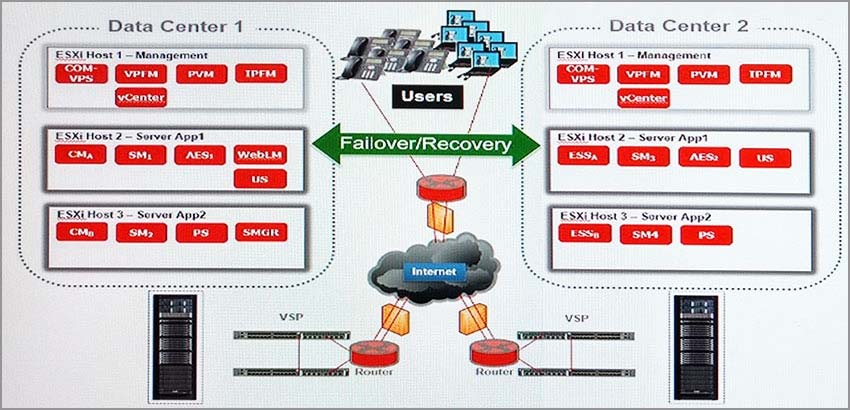
Refer to the exhibit.
In the deployment shown in the exhibit, how is High Availability achieved across the two Data Centers?
- A. by using Virtualization Provisioning Service (VPS) to automate the provisioning of the network hardware and vSwitches across the two Data Centers
- B. by managing both Data Centers using the same vCenter Server and using vMotion & DRS
- C. by using Aura Applications"™ High Availability features
- D. by ensuring that there the L2 VLANs are extended across to both Data Centers
Answer : A
Question 4
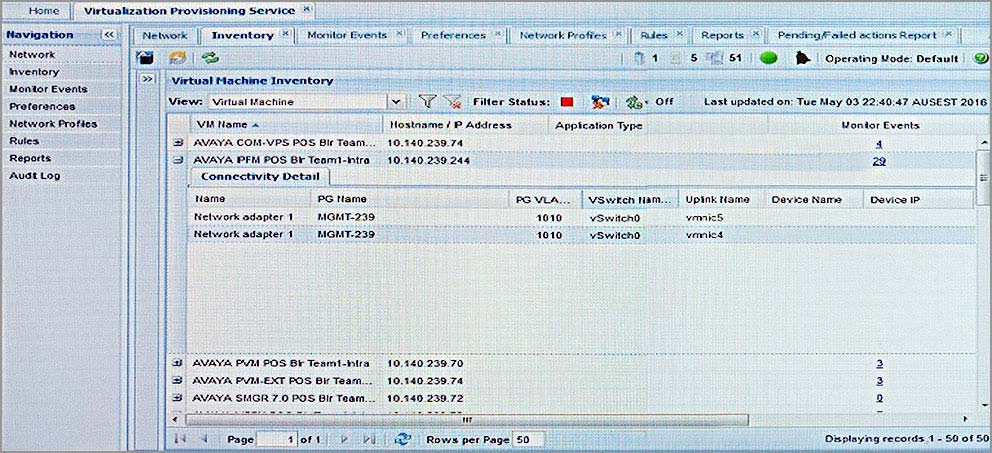
Refer to the exhibit.
Which statement about Network adapter 1 is true?
- A. Its physical layer redundancy is provided by vmnic4 and vmnic5.
- B. It is not mapped to Priority Group MGMT-239.
- C. It is a Tagged port with 802.1Q VLAN tag of 1010.
- D. It is listed twice because there is a Primary and a Secondary instance of the adapter.
Answer : A
Question 5
With Pod Fx, what is mandatory to ensure High Availability across the two Data Centers?
- A. a single vCenter Server that manages both Data Centers
- B. network connectivity to and in between the two Data Centers
- C. identical compute servers in both Data Centers
- D. the same VLANs in both Data Centers
Answer : A
Question 6
Who is responsible to ensure that the IP Template for Pod Fx is correctly filled?
- A. Avaya Implementation Engineers
- B. Avaya Support Engineers
- C. BP implementation engineers
- D. Sales Engineers
Answer : D
Question 7
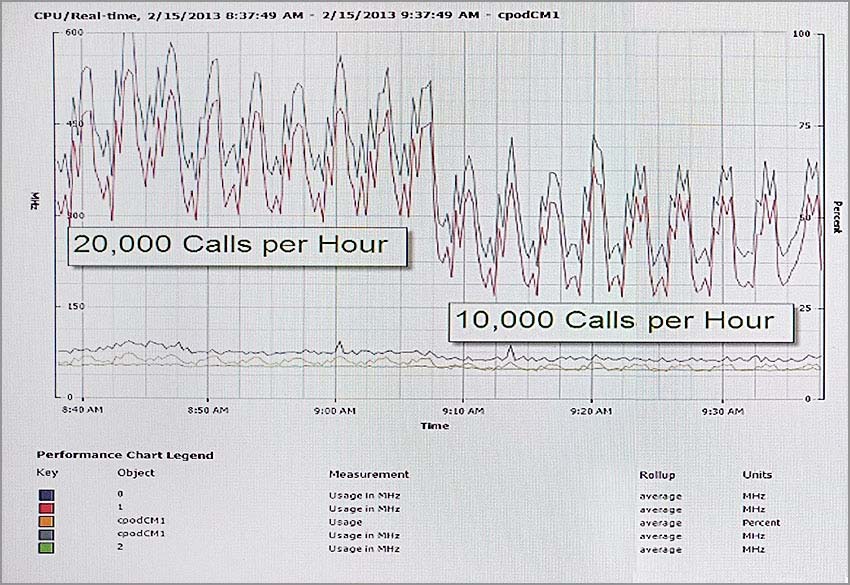
Refer to the exhibit.
The CPU performance of Communication Manager (CM) shows a significant difference depending on the call rates.
Which statement about making configuration changes is true?
- A. Increasing the number of Virtual CPUs allocated to CM might help to reduce this difference.
- B. Ensuring that a secondary CM is available to allow for load balancing might help to reduce this difference.
- C. Migrating the CM Virtual Machine to another ESXi host that is less busy might help to reduce this difference.
- D. Reducing this difference is not necessary because this is expected behavior.
Answer : B
Question 8
Under certain circumstances, the integration process between SMGR and POS applications must be performed in the field to create the launch links to POS applications.
Which two circumstances would cause this situation to occur? (Choose two.)
- A. when a new service pack installation is taking place outside the supported software line up
- B. when a POS application is being deployed due to product malfunction
- C. when a new Avaya Aura® application is being added to the Pod
- D. when a new ESXi host is being added to Pod Visualization Manager (PVM)
Answer : BD
Question 9
When providing BYOD access control, which role does Identity Engines (IDE) play?
- A. Policy Decision Point
- B. Policy Enforcement Point
- C. Policy Identity Point
- D. Policy Information Point
Answer : A
Reference -
https://www.avaya.com/en/product/identity-engines/
Question 10

Refer to the exhibit.
Which Avaya Session Border Controller for Enterprise (ASBCE) configuration option is shown?
- A. Hybrid
- B. Geographic Redundancy
- C. High Availability
- D. Two-wire
Answer : C
Question 11
Which statement about the factory default configuration of the Avaya Session Border Controller for Enterprise (ASBCE) in Pod Fx is true?
- A. The A1 LAN interface of the SBC is connected to the Pod"™s Application 3 VLAN.
- B. The A1 LAN interface of the SBC is connected to the Pod"™s Application 1 VLAN.
- C. The B1 LAN interface of the SBC is connected to the Pod"™s Application 2 VLAN.
- D. The M1 LAN interface of the SBC is connected to the Pod"™s Application 3 VLAN.
Answer : A
Reference:
https://downloads.avaya.com/css/P8/documents/101001303
Question 12
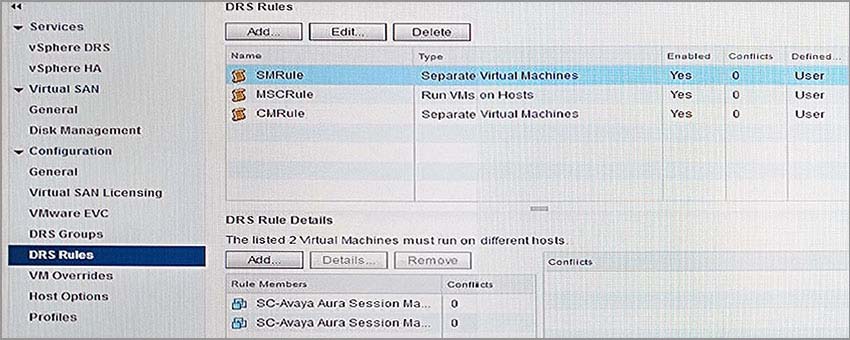
Refer to the exhibit.
What is the purpose of the "SMRule" DRS rule that states the two Avaya Aura® Session Managers must run of different ESXi hosts?
- A. to improve the latency of DRS load-balancing
- B. to preserve seamless failover/recovery across primary and secondary Session Managers
- C. to reduce the memory and CPU load on a single ESXi host
- D. to prevent a single ESXi host from being overloaded with SIP traffic
Answer : B
Question 13
Which statement describes the purpose of enabling VMware Enhanced vMotion Compatibility (EVC)?
- A. EVC prevents vMotion migrations from failing because of incompatible CPUs across the cluster.
- B. EVC prevents vMotion migrations from failing because of insufficient memory across the cluster.
- C. EVC prevents vMotion migrations from failing because of incompatible HA rules across the cluster.
- D. EVC prevents vMotion migrations from failing because of incompatible DRS rules across the cluster.
Answer : A
Reference -
https://pubs.vmware.com/vsphere-4-esx-vcenter/index.jsp?topic=/com.vmware.vsphere.resourcemanagement.doc_41/creating_a_drs_cluster/ c_drs_cluster_prerequisites.html
Question 14
Which statement about all hosts in the cluster describes a system requirement for VMware vMotion in Pod Fx?
- A. They must have matching Memory capacity.
- B. They must have matching CPU types.
- C. They must have matching VMware network settings.
- D. They must be the same server type.
Answer : B
Question 15
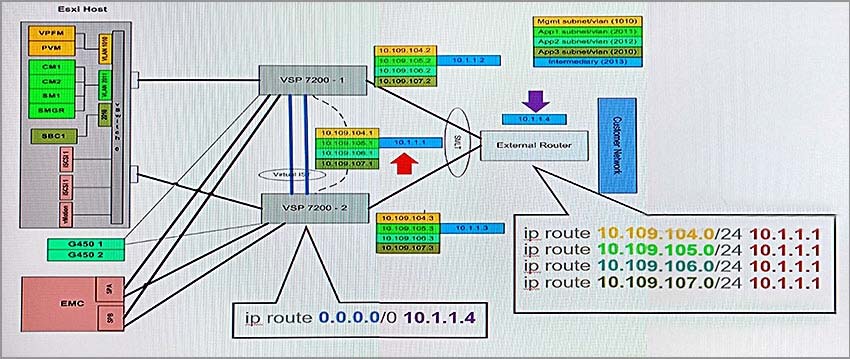
Refer to the exhibit.
What does the IP address 10.1.1.1 represent?
- A. the SMLT IP address of the two VSP 7200 switches
- B. the IP address of the EMC storage
- C. the Virtual IST IP address of the two VSP 7200 switches
- D. the VRRP IP address of the two VSP 7200 switches
Answer : D